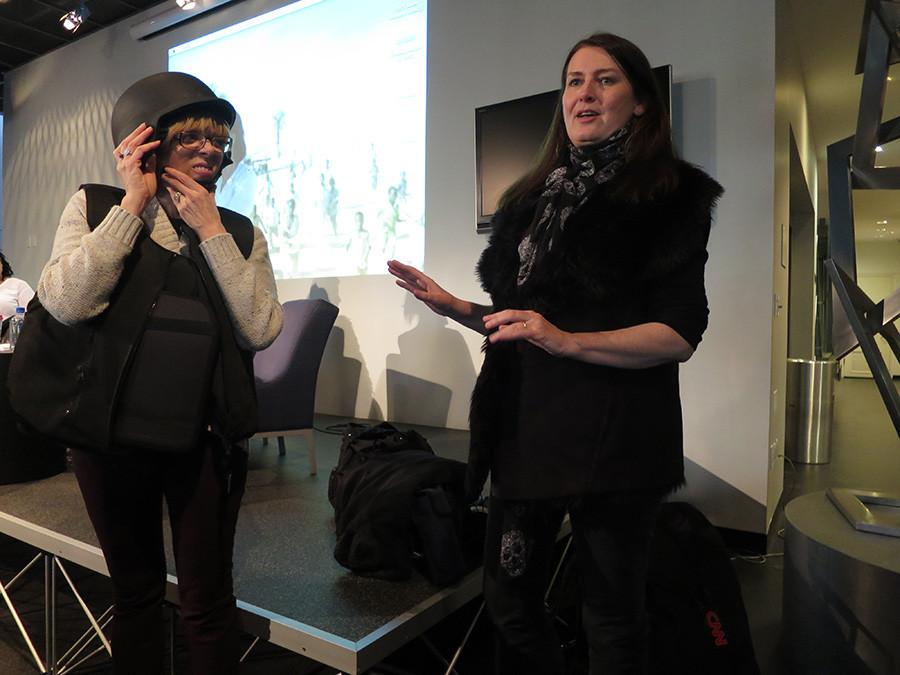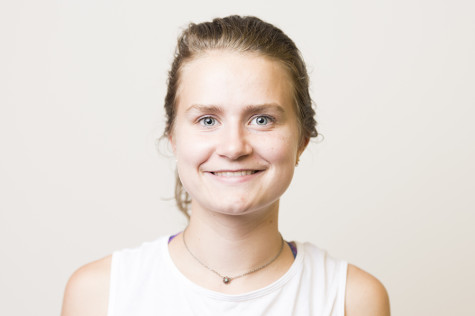Female journalists discuss crisis reporting
A volunteer from the audience tries on filmmaker Carol Cassidy’s bulletproof vest and flak helmet, two relics of working on conflict zones.
March 25, 2015
Crisis reporting is often considered a male-dominated field, but panelists said this discrimination can be used as an advantage for women in journalism in “Filming on the Frontlines: How to Manage Risky Situations.”
Kirsten Johnson, a cinematographer whose work includes “Citizenfour,” and Carol Cassidy, an independent producer, particularly refuted the idea that the challenges of sexism and combat are too great, saying that being a woman is
actually beneficial.
Johnson said the prejudice actually works in her favor as a crisis reporter, allowing her to slip through security cracks where a male might be challenged.
“That can be really useful,” Johnson said. “You don’t even have to play dumb, people just assume you’re dumb and then you can continue on.”
Johnson was detained in Abu Dhabi with Laura Poitras, who has been famously detained because of her work, after showing Poitras’ film “The Oath” about detainees in Guantanamo.
“That was the first time I was detained,” Johnson said. “One of my favorite moments ever was that the border guard said, ‘So do you find the people to talk to and ask the questions, or do you just hold the camera?’ And I was like, ‘I just hold the camera.’”
Cassidy brought items from her reporting experience, including a bulletproof vest, flak helmet and burqa, which she said is often seen as political statement.
“I wanted to bring my burqa,” Cassidy said. “To me, this is a cloak of invisibility. And in certain places, it’s a beautiful thing to be able to just use this on the streets.”
Cassidy pointed out that these items leave a lot of areas uncovered — even wearing the gear, a reporter is not totally safe and is still vulnerable.
“Fortunately, your vulnerability is a key tool in doing this kind of field production,” she said. “You want to bring your humanity to work. And one of those things is your physicality.”
Johnson added that crisis reporting is an ever shifting field and reporters have to be able to adapt to that.
“The thing for me that’s really interesting about this work is that you keep trying to understand the world and the world keeps changing,” Johnson said.
CAS sophomore Ananya Bhattacharya, who attended the panel, said it was simplistic and general. Despite this, she says she enjoyed the discussion.
“It was great that there was a camera person and a producer and a director,” Bhattacharya said. “Different people because you get different responsibilities with those duties. That was good.”
Documenting humanity is not just important in international news, but also in domestic, as Claire Ward, cinematographer for Vice News discussed. Her most recent conflict reporting was in Ferguson. Vice reported via livestream in attempt to just spread the word about what was happening.
“We just kept rolling,” Ward said. “It just felt like a historical moment. It really did feel like we were there to document it in the most traditional sense. To just open the lense and keep rolling and figure out what it all meant later.”
A version of this article appeared in the Wednesday, March 25 print edition. Email Justine Morris at [email protected].




























































































































































